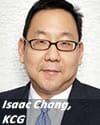Changes in the structure of the interest rate derivatives market will open up the field to new entrants such as KCG, while margin costs will gradually lead to the ‘futurisation’ of the market, according to Isaac Chang, the firm’s global head of fixed income.
In January, KCG – the result of a merger between market makers Getco and Knight Capital – signalled its interest in moving into the interest rate swaps market, potentially before the end of the year.
In an interview with theTRADEnews.com, Chang said the regulation-driven migration of the voice-broked, bilateral interest rate swaps market to central clearing and execution on electronic platforms created new opportunities for KCG.
“Many traditional suppliers of liquidity are experiencing severe constraints on capital at present. Combined with the mitigation of long-dated credit concerns via central clearing, that opens up an opportunity for new liquidity providers,” he said.
“As an experienced liquidity provider in the futures markets, we’d certainly consider moving into the evolving rates space if the volumes justify it, whether that’s through a swap execution facility (SEF) or on-exchange. You have to bear in mind that there are a lot of costs to being a swap dealer, including margin, and the infrastructure needed for clearing, reporting and connectivity etc.”
Since October, it has been possible to trade liquid interest rate swaps on SEFs, but from next week market participants will be obliged to trade a number of benchmark swaps on the new platforms, following the granting of a ‘made available to trade’ application by Javelin SEF.
Javelin offers a choice of trading via the traditional request-for-quote (RFQ) protocol or on a central limit order book (CLOB), but KCG’s Chang sees a gradual drift of volume from the former to the latter.
“RFQ is how swaps have been traded electronically to date. How swaps liquidity now evolves across RFQ and CLOBs is one of the key questions. On day one of mandated SEF trading, most of the trading will stay RFQ because that’s what everybody knows. But whether it’s three, six or 18 months in the future, ease-of-use considerations will drive most vanilla swaps onto central limit order books.”
But the evolution of the interest rate derivatives market does not stop with SEFs. Established US listed derivatives exchanges have offered futures products that provide a similar exposure to swaps, but with substantially lower up-front costs.
“One clear benefit of futures over swaps is initial margin,” says Chang. “In such a cash constrained environment, initial margin matters. And when 2.5 times more margin is required for swaps than futures, it’s hard to see why you wouldn’t choose futures.”
So far it has been hard to identify the preferences of market participants, but many believe that the upcoming obligation to trade very liquid interest rate swaps on SEFs will force the market to decide.
“Everyone knows the margin issues are there, but they haven’t had to face up to them because volumes haven’t taken off yet. Margin efficiency matters more for some than others,” says Chang. “If you’re a long-only pension fund, you’re going to care less about margin efficiency than a hedge fund, for example, that might be more tactical in its trading strategy with a number of bets across different swaps and futures. With swaps, there’s still a lot of questions outstanding on how cross-margining will work and whether it can deliver efficiencies to the end-user.”
